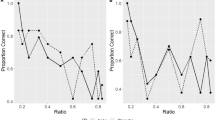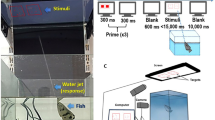Abstract
This study investigated whether Asian elephants can make relative quantity judgment (RQJ), a dichotomous judgment of unequal quantities ordered in magnitude. In Experiment 1, elephants were simultaneously shown two baskets with differing quantities of bait (up to 6 items). In Experiment 2, elephants were sequentially presented with baits, which could not be seen by elephants in their total quantities. The task of elephants was to choose the larger quantity in both experiments. Results showed that the elephants chose the larger quantity with significantly greater frequency. Interestingly, the elephants did not exhibit disparity or magnitude effects, in which performance declines with a smaller difference between quantities in a two-choice task, or the total quantity increases, respectively. These findings appear to be inconsistent with the previous reports of RQJ in other animals, suggesting that elephants may be using a different mechanism to compare and represent quantities than previously suggested for other species.





Similar content being viewed by others
References
Anderson US, Stoinski TS, Bloomsmith MA, Marr MJ, Smith AD, Maple TL (2005) Relative numerousness judgment and summation in young and old Western Lowland Gorillas. J Comp Psychol 119:285–295
Anderson US, Stoinski TS, Bloomsmith MA, Maple TL (2007) Relative numerousness judgment and summation in Young, middle-aged, and older adult Orangutans (Pongo pygmaeus ablii and Pongo pygmaeus pygmaeus). J Comp Psychol 121:1–11
Beran M (2001) Summation and numerousness judgments of sequentially presented sets of items by chimpanzees (Pan troglodytes). J Comp Psychol 115:181–191
Beran M (2007) Rhesus monkeys (Macaca mulatta) succeed on computerized test designed to assess conservation of discrete quantity. Anim Cogn 10:37–45
Beran MJ, Beran MM, Harris EH, Washburn DA (2005) Ordinal judgments and summation of nonvisible sets of food items by two chimpanzees and a rhesus Macaque. J Exp Psychol Anim Behav Process 31(3):351–362
Biro D, Matsuzawa T (2001) Use of numerical symbols by the chimpanzee (Pan troglodytes): Cardinals, ordinals, and the introduction of zero. Anim Cogn 4:193–199
Boysen ST, Berntson GG (1989) Numerical competence in a chimpanzee. J Comp Psychol 103:23–31
Boysen ST, Bernston GG (1995) Responses to quantity: perceptual versus cognitive mechanisms in chimpanzees (Pan Troglodytes). J Exp Psychol 21:82–86
Boysen ST, Bernston GG, Mukobi KL (2001) Size matters: impact of item size and quantity on array choice by chimpanzees (Pan troglodytes). J Comp Psychol 115:106–110
Call J (2000) Estimating and operating on discrete quantities in orangutans (Pongo pygmaeus). J Comp Psychol 114:136–147
Davis H, Bradford SA (1986) Counting behavior by rats in a simulated natural environment. Ethology 73:265–280
Davis H, Perusse R (1988) Numerical competence in animals: definitional issues, current evidence, and a new research agenda. Behav Brain Sci 11:561–615
Davis H, MacKenzie KA, Morrison S (1989) Numerical discrimination by rats (Rattus norvegicus) using body and vibrissal touch. J Comp Psychol 103:45–53
Dehaene S (1997) The number sense. Oxford University Press, New York
Dehaene S, Cohen L (1994) Dissociable mechanisms of subitizing and counting: Neuropsychological evidence from simultanagnosic patients. J Exp Psychol Hum Percept Perform 20:958–975
Dehaene S, Dupoux E, Mehler J (1990) Is numerical comparison digital? Analogical and symbolic effects in two-digit number comparison. J Exp Psychol Hum Percept Perform 16:958–975
Feigenson L, Carey S, Hauser M (2002) The representations underlying infants’ choice of more: object files versus analog magnitudes. Psychol Sci 13:150–156
Gallistel CR, Gelman R (2000) Non-verbal numerical cognition: from reals and integers. Trends Cogn Sci 4:59–65
Hauser MD, Carey S, Hauser LB (2000) Spontaneous number representation in semi-free-ranging rhesus monkeys. Proc Biol Sci 267(1445):829–833
Hauser MD, Kralik J, Botto-Mahan C (1999) Problem solving and functional design features: experiments on cotton-top tamarins, Saguinus oedipus oedipus. Anim Behav 57:565–582
Hauser MD, Santos LR, Spaepen GM, Pearson HE (2002) Problem solving, inhibition and domain-specific experience: Experiments on cottontop tamarins, Saguinus oedipus. Anim Behav 64:387–396
Hicks LH (1956) An analysis of number-concept formation in the rhesus monkey. J Comp Physiol Psychol 49:212–218
Irie-Sugimoto N, Kobayashi T, Sato T, Hasegawa T (2008) Evidence of means-end behavior in Asian Elephants (Elephas maximus). Anim Cogn 11:359–365
Kahneman D, Treisman A, Gibbs BJ (1992) The reviewing of object files: object-specific integration of information. Cogn Psychol 24:174–219
Kaufman EL, Lord MW, Reese TW, Volkmann J (1949) The discrimination of visual number. Am J Psychol 62:498–525
Kobayashi T, Hiraki K, Hasegawa T (2005) Auditory-visual intermodal matching of small numerosities in 6-month-old infants. Dev Sci 8(5):409–419
Leslie AM, Xu F, Tremoulet PD, Scholl BJ (1998) Indexing and the object concept: developing “what” and “where” systems. Trends Cogn Sci 2:10–28
Mandler G, Shebo BJ (1982) Subitizing: An analysis of its component processes. J Exp Psychol Gen 111:1–22
Matsuzawa T (1985) Use of numbers by a chimpanzee. Nature 315:57–59
Meck WH, Church RM (1983) A mode control model of counting and timing processes. J Exp Psychol Anim Behav Process 9:320–334
Moyer RS, Landauer TK (1967) Time required for judgments of numerical inequality. Nature 215:1519–1520
Olthof A, Roberts WA (2000) Summation of Symbols by Pigeons (Columba livia): The Important Number and Mass of Reward Items. J Comp Psychol 114:158–166
Pepperberg I (1987) Evidence for conceptual quantitative abilities in the African grey parrot: Labeling of cardinal sets. Ethology 75:37–61
Perusse R, Rumbaugh DM (1990) Summation in Chimpanzees (Pan troglodytes): Effects of Amounts, Number of Wells, and Finer Ratios. Inter J Primatol 11(5):425–437
Plotnik JM, de Waal FBM, Reiss D (2006) Self-recognition in an Asian elephant. PNAS 103:17053–17057
Povinelli DJ, Rulf AB, Landau KR, Bierschwale DT (1993) Self-recognition in chimpanzees (Pan troglodytes): Distribution, ontogeny, and patterns of emergence. J Comp Psychol 107(4):347–372
Rumbaugh DM, Savage-Rumbaugh ES, Hegel MT (1987) Summation in the chimpanzee (Pan troglodytes). J Exp Psychol Anim Behav Process 13:107–115
Rensch B (1957) The Intelligence of Elephants. Sci Am 196:44–49
Suarez SD, Gallup GG (1981) Self-recognition in Chimpanzees and Orangutans, but not Gorillas. J Hum Evol 10:175–188
Suzuki K, Kobayashi T (2000) Numerical competence in rats (Rattus norvegicus): Davis & Bradford (1986) extended. J Comp Psychol 114(1):73–85
Terrell DF, Thomas RK (1990) Number-related discrimination and summation by squirrel monkeys (Saimiri sciureus sciureus and S. boliviensus boliviensus) on the basis of the number of sides of polygons. J Comp Psychol 104:238–247
Trick L, Pylyshyn ZW (1994) Why are small and large numbers enumerated differently? : a limited capacity preattentive stage in vision. Psychol Rev 101:80–102
Thomas R, Chase L (1980) Relative numerousness judgments by squirrel monkeys. Bull Psychon Soc 16:79–82
Tomasello M, Call J (1997) Primate cognition. Oxford University Press, Oxford
Uller C, Carey S, Huntley-Fenner G, Klatt L (1999) What representations might underlie infant numerical knowledge. Cogn Dev 14(1):1–36
Uller C, Hauser M, Carey S (2001) The spontaneous representation of number in a New World primate species, Cotton-top tamarins. J Comp Psychol 115(3):1–10
Uller C, Jaeger R, Guidry G, Martin C (2003) Salamanders (Plethodon cinereus) go for more: rudiments of number in an amphibian. Anim Cogn 6:105–112
von Glasersfeld E (1982) Subitizing: The role of figural patterns in the development of mumerical concepts. Archives de Psychologie 50:191–218
Wynn K (1998) Psychological foundations of number: numerical competence in human infants. Trends Cogn Sci 2:296–303
Xu F, Spelke E (2000) Large number discrimination in 6-month-old infants. Cognition 74:B1–B11
Acknowledgments
We wish to thank the directors and keepers at Ueno Zoological Garden and Ichihara Elephant Kingdom, and their elephants for their participation in the study. We also like to thank Dr. Takafumi Ishida for his editorial support. These experiments comply with the current laws of Japan and the animals are kept at the standards established by Japanese Association of Zoos and Aquariums.
Author information
Authors and Affiliations
Corresponding author
Rights and permissions
About this article
Cite this article
Irie-Sugimoto, N., Kobayashi, T., Sato, T. et al. Relative quantity judgment by Asian elephants (Elephas maximus). Anim Cogn 12, 193–199 (2009). https://doi.org/10.1007/s10071-008-0185-9
Received:
Revised:
Accepted:
Published:
Issue Date:
DOI: https://doi.org/10.1007/s10071-008-0185-9




